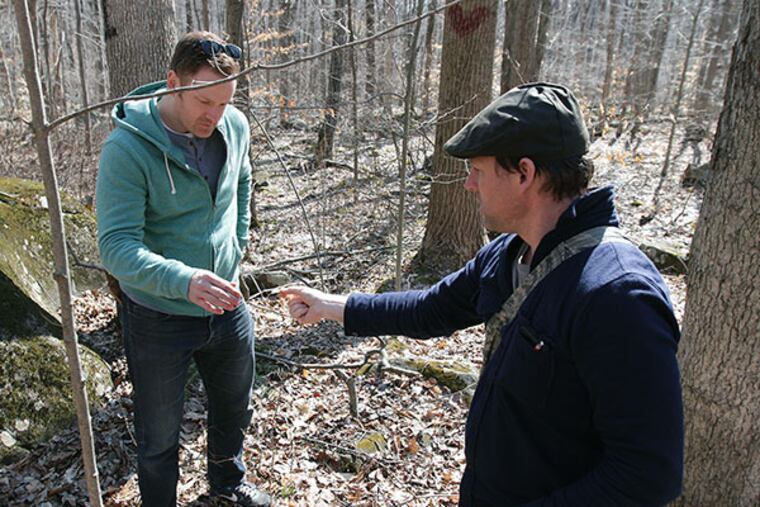Stalking wild food with Eli Kulp
Forkand High Street on Market chef and renowned forager Evan Strusinski look for dinner ingredients in the woods.

THERE is nothing trendy about foraging. Seeking wild edibles to add to what's for dinner is a quest that preoccupied our ancestors from the days when Homo sapiens first cozied up in caves.
Our hairy predecessors really didn't have a choice - farm to table was more like bark, blossom and berry to belly, or go hungry. Along with hunting, gathering has pretty much fed the human race forever and it continues to do so in many places.
To chef Eli Kulp and his crew at Fork and High Street on Market, foraging is a way to get out of the kitchen, connect with food at its most basic level and have fun.
It also is a means to introduce local wild foods to the restaurant's customers - delicious ingredients like ramps, nettles, dandelion and wild chervil. Kulp grew up in Washington state and remembers highways lined with people harvesting buckets of chanterelles during the prized fungi's short season.
"I think foraging is more common on the West Coast, but it's popular here, too," said the chef, recently named one of Food & Wine magazine's Best New Chefs for 2014. "It's important for people to understand that foraging is the ultimate way to eat sustainably and locally. It's not just farm to table, it's field to table."
Nature's exotic ingredients
Kulp and Fork/High Street baker Alex Bois take frequent field trips in search of seasonal ingredients. "Alex is amazing," Kulp said. "He's the kind of guy who sees food everywhere, anytime he's outside taking a walk."
On a recent ramble into the wilds near Princeton, N.J., Kulp and Bois teamed up with Evan Strusinski, described a few years ago in Outside magazine as "a foraging savant who stalks the remote woods and coastlines of the Northeast for nature's most exotic ingredients."
Strusinski is a Vermont native who spends half the year foraging along the East Coast and supplying wild edibles to A-list restaurants like Fork and Serpico here, and Momofuku and Gramercy Tavern in New York.
"Evan's the real deal," Kulp said. "He's got every big chef on speed dial - and they want to hear from him."
Strusinski's eye for unusual wild foods - backed up with encyclopedic knowledge - is one reason that chefs have come to rely on him. Like most foragers, Strusinski started out just taking a walk and bumping into the odd bit by chance. He now can easily identify more than 300 species of wild plants and mushrooms.
"Anyone who thinks foraging is simple hasn't really done it," he said. Of course, as with anything, the more you do it, the easier it becomes.
"After a while, identifying 45 varieties of wild mushrooms is as simple as identifying carrots in the grocery store," he said. "Time and experience makes it impossible for me to misidentify a black trumpet mushroom or a chanterelle."
A 'safe, natural process'
Strusinski and Kulp have dealt with what Strusinski calls "hysteria" - the occasional restaurant patron afraid of being poisoned by a look-alike mushroom, for example.
"You have a much greater chance getting E. coli from something produced on a factory farm," Kulp said. "What we do is a very safe, natural practice. We are not irresponsible; we are conservative and stay within areas we are familiar with. My patrons trust me to make them delicious food. I would never allow anything to compromise that."
Organic farmer Casey Spacht has been losing himself in the woods and eating off the land since he was a kid growing up in hardscrabble circumstances in Lancaster County. Spacht, co-founder and general manager of Lancaster Farm Fresh Cooperative, leads DIY foraging treks, like the April 13 session he led in conjunction with the Philadelphia Restaurant School.
His first field guide, Stalking the Wild Asparagus, published in 1962 by Euell Gibbons, is well-worn. He also likes Samuel Thayer's guides, The Forager's Harvest and Nature's Garden.
To Spacht's way of thinking, foraging is the ultimate way to eat sustainably and think green.
"When you're out foraging, and come across a fox den or other kinds of wildlife, it makes you want to protect these spaces," he said. "I tell people to notice everything - it's not just about the greens or mushrooms. Really look around you and see where food comes from."
As to the trustworthiness of wild edibles, Spacht sees no issue. "You trust a chef to cook food for you. That person is going to make a judgment. They're not going to prepare something that is going to hurt you. We trust the people who make the processed junk we put in our bodies made with names we can't even pronounce. Of course it makes sense to trust a chef."
Now that the dreary, frozen winter is really in the rearview mirror, spring is transforming the landscape, dishing up seasonal treats like garlic scapes, wild onions and hickory bark for those in the know. On their New Jersey walkabout, Kulp and Strusinski uncovered edible trout lily, peppercress, wild chives and hickory bark, among other delectables.
"But you really don't have to go deep into the woods," Strusinski said. "As soon as you step out of your house, no matter where you live, you're going to pass common edible plants. Figuring out what to do with them is the fun part."